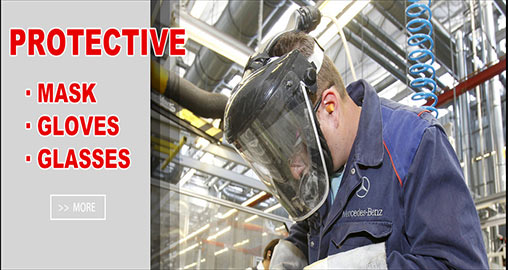Welding is a processing process widely used in industrial production, through heating, pressure to process the metal, so that two pieces of metal together.The American Welding Society (AWS) has recognized more than 50 different types of welding, such as shielded metal arc welding (SMAW) , stick welding, gas metal arc welding (GMAW) also known as MIG/MAG welding process, Gas tungsten arc welding (GTAW), TIG Welding, Submerged arc welding (SAW) and Flux-cored arc welding (FCAW), etc. Many industrial types come into contact with welding in production. What safety measures do you need to pay attention to when carrying out welding work? First of all, we need to understand the harm of welding; welding safety measures are essential.
Welding operations involve fire, burns, radiation heat (infrared radiation), inhalation of metal fumes, and other hazards of contaminants. Welding process will produce a large amount of metal dust; long-term inhalation will lead to welding pneumoconiosis, the use of permanganate welding rod welding, easy to drive to occupational manganese poisoning, welding soot iron oxide, manganese oxide particles, and fluoride through the lungs into the human body, will lead to welding metal heat.
Harmful gases produced during welding, such as ozone, nitrogen oxides, carbon monoxide, hydrogen fluoride, etc., can damage the body's respiratory system, nervous system function (e.g., pneumonia, bronchitis, etc.);Also, high-frequency electromagnetic fields, radioactive materials, noise on the human body's physiological function will cause specific damage.Many welding operations are carried out at operating sites such as construction sites, where welders must be installed and operated with facilities on site, which can also result in physical strain, excessive fatigue, and muscle damage. Heat damage can also occur on hot days or due to the blocking of personal protective equipment.
Welding protective supplies mainly include safety helmets, safety shoes, professional welding gloves; anti-toxic masks to reduce smoke inhalation into the body; welding masks, welding work clothes to avoid skin exposure. Welding protective supplies for welding work to provide a full range of professional protection must be carried out regular maintenance, to facilitate the reasonable and safe use of welding protective supplies. As a supplier of industrial protection products, as an industrial welding supplier, T-safety offers a list of welding protection products, and here are some product displays that I hope will help you.
A welding helmet is a type of headgear used when performing certain types of welding to protect the eyes, face, and neck from flash burn, ultraviolet light, sparks, infrared light, and heat.
Hard hat welding helmets are most commonly used with arc welding processes such as shielded metal arc welding, gas tungsten arc welding, and gas metal arc welding. They are necessary to prevent an arc eye, a painful condition where the cornea is inflamed.
The most basic conditions, cover with industrial dust, anti-dust effect;
To metal smoke (e.g., metal iron, manganese, aluminum, chromium) can be adequately protected;
Anti-virus mask-wearing comfortable breathable, suitable for long-term wear;
The mask has flame retardant properties. (This feature does not have to be satisfied)
To prevent the hazards of welding arc light and burns, the use of light-shielding lenses that meet the working conditions.
Welder masks with handheld or head-mounted housings, costumes, and helmets. Chose hard-to-burn or non-combustible materials, cover the face and ear, the structure is stable, with no leakage.
Head-mounted welding mask for all types of arc welding or high welding operations.
Auxiliary welders should choose to wear masks suitable for their light-shielding properties according to working conditions and protective glasses.
Gas welding, gas cutting operations, should be based on the thickness of solder, cutting workpiece board, select use the appropriate type of protective spectacle lenses.
Welder work clothes should be selected according to the characteristics of welding and cutting work.
Cotton work clothes are widely used in welding, cutting practice, the color of the work clothes is blue.
Gas protection welding under the action of ultraviolet light will produce ozone and other gases should be selected Work clothes made of coarse wool or leather and other fabrics to prevent welders from being burned or hyperthermia during operation.
Welders working in full welding positions should be equipped with leatherwork clothes.
In the back welding cutting, to prevent Mars, slag from high splashing on the head and shoulders, welders should be around the neck towel, wearing a shoulder protector made of anti-combustion material, long sleeves, aprons, and shoe covers.
Welding Gloves. T-Safety offers only the highest quality brand name welding gloves, for general welding applications, Superior has many styles to choose from depending on the heat protection, abrasion, vibration resistance, ability, and durability you require.Superior offers a wide range of welding gloves and apparel. The S06607 is very popular for TIG welding and is available in various types of leather.
Welders wearing work clothes should not be wet, work clothes pockets should be bag cover, the body should cover the waist; pants should cover the top stool, work clothes should not be broken, holes and crevices, do not allow oil.

For a variety of reasons, you need protective shoes, first of all, to prevent physical injury.When welding, there is a risk of cuts, cuts, electric shocks, contamination, sprains, ruptures, burns and crushing. The risk of personal injury can be significantly reduced by wearing protective equipment.Welding safety boots allows you to work longer without feeling discomfort or pain. They also give you extra protection in an emergency.
Also, it's not illegal to look good at work. High-end protective boots add color to your garment, so you can visit the welding boots category without worrying about your appearance.The accident can occur within one second. Don't wear substandard shoes.
Health protection against occupational hazards: the workplace should have proper ventilation facilities, good ventilation, and local ventilation, and use welding materials with a relatively small degree of occupational hazards as far as possible. Regular professional health check-ups should be conducted for persons engaged in welding and cutting operations for a long time.
Copyright © Hebei Sinotools Industrial Co.,Ltd. All Rights Reserved | Powered by  Sitemap
Sitemap